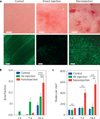Biodegradable silicon nanoneedles delivering nucleic acids intracellularly induce localized in vivo neovascularization
- PMID: 25822693
- PMCID: PMC4538992
- DOI: 10.1038/nmat4249
Biodegradable silicon nanoneedles delivering nucleic acids intracellularly induce localized in vivo neovascularization
Abstract
The controlled delivery of nucleic acids to selected tissues remains an inefficient process mired by low transfection efficacy, poor scalability because of varying efficiency with cell type and location, and questionable safety as a result of toxicity issues arising from the typical materials and procedures employed. High efficiency and minimal toxicity in vitro has been shown for intracellular delivery of nuclei acids by using nanoneedles, yet extending these characteristics to in vivo delivery has been difficult, as current interfacing strategies rely on complex equipment or active cell internalization through prolonged interfacing. Here, we show that a tunable array of biodegradable nanoneedles fabricated by metal-assisted chemical etching of silicon can access the cytosol to co-deliver DNA and siRNA with an efficiency greater than 90%, and that in vivo the nanoneedles transfect the VEGF-165 gene, inducing sustained neovascularization and a localized sixfold increase in blood perfusion in a target region of the muscle.
Figures






Comment in
-
Drug delivery: Puncturing cells en masse.Nat Mater. 2015 May;14(5):470-1. doi: 10.1038/nmat4274. Nat Mater. 2015. PMID: 25899907 No abstract available.
References
Publication types
MeSH terms
Substances
Grants and funding
LinkOut - more resources
Full Text Sources
Other Literature Sources

